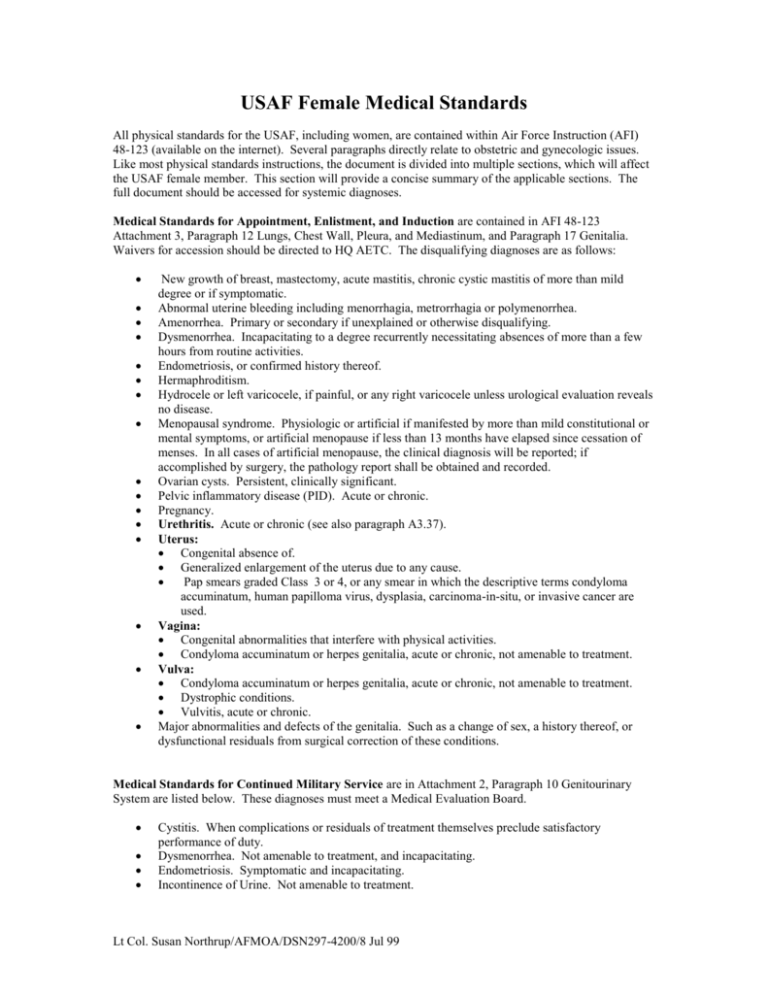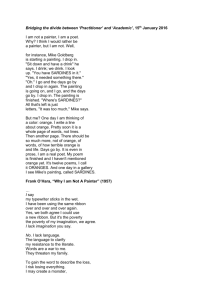USAF Female Medical Standards
advertisement

USAF Female Medical Standards All physical standards for the USAF, including women, are contained within Air Force Instruction (AFI) 48-123 (available on the internet). Several paragraphs directly relate to obstetric and gynecologic issues. Like most physical standards instructions, the document is divided into multiple sections, which will affect the USAF female member. This section will provide a concise summary of the applicable sections. The full document should be accessed for systemic diagnoses. Medical Standards for Appointment, Enlistment, and Induction are contained in AFI 48-123 Attachment 3, Paragraph 12 Lungs, Chest Wall, Pleura, and Mediastinum, and Paragraph 17 Genitalia. Waivers for accession should be directed to HQ AETC. The disqualifying diagnoses are as follows: New growth of breast, mastectomy, acute mastitis, chronic cystic mastitis of more than mild degree or if symptomatic. Abnormal uterine bleeding including menorrhagia, metrorrhagia or polymenorrhea. Amenorrhea. Primary or secondary if unexplained or otherwise disqualifying. Dysmenorrhea. Incapacitating to a degree recurrently necessitating absences of more than a few hours from routine activities. Endometriosis, or confirmed history thereof. Hermaphroditism. Hydrocele or left varicocele, if painful, or any right varicocele unless urological evaluation reveals no disease. Menopausal syndrome. Physiologic or artificial if manifested by more than mild constitutional or mental symptoms, or artificial menopause if less than 13 months have elapsed since cessation of menses. In all cases of artificial menopause, the clinical diagnosis will be reported; if accomplished by surgery, the pathology report shall be obtained and recorded. Ovarian cysts. Persistent, clinically significant. Pelvic inflammatory disease (PID). Acute or chronic. Pregnancy. Urethritis. Acute or chronic (see also paragraph A3.37). Uterus: Congenital absence of. Generalized enlargement of the uterus due to any cause. Pap smears graded Class 3 or 4, or any smear in which the descriptive terms condyloma accuminatum, human papilloma virus, dysplasia, carcinoma-in-situ, or invasive cancer are used. Vagina: Congenital abnormalities that interfere with physical activities. Condyloma accuminatum or herpes genitalia, acute or chronic, not amenable to treatment. Vulva: Condyloma accuminatum or herpes genitalia, acute or chronic, not amenable to treatment. Dystrophic conditions. Vulvitis, acute or chronic. Major abnormalities and defects of the genitalia. Such as a change of sex, a history thereof, or dysfunctional residuals from surgical correction of these conditions. Medical Standards for Continued Military Service are in Attachment 2, Paragraph 10 Genitourinary System are listed below. These diagnoses must meet a Medical Evaluation Board. Cystitis. When complications or residuals of treatment themselves preclude satisfactory performance of duty. Dysmenorrhea. Not amenable to treatment, and incapacitating. Endometriosis. Symptomatic and incapacitating. Incontinence of Urine. Not amenable to treatment. Lt Col. Susan Northrup/AFMOA/DSN297-4200/8 Jul 99 Congenital anomaly, resulting in frequent or recurring infections or when there is evidence of obstructive uropathy not responding to medical or surgical treatment. Pyelonephritis or pyelitis, chronic, which has not responded to medical or surgical treatment, with evidence of persistent hypertension or reduction in renal function. Menopausal or Premenstral syndrome. Physiologic or artificial, significantly interfering with the satisfactory performance of duty. Strictures of the urethra or ureter. Severe and not amenable to treatment. Urethritis. Chronic, not responsive to treatment and necessitating frequent absences from duty. Cystectomy. Cystoplasty. If reconstruction is unsatisfactory, or if refractory symptomatic infections persist. Nephrectomy. When after treatment, there is infection or pathologic change (anatomic or functional) in the remaining kidney. Nephrostomy or pyelostomy, if drainage persists. Gonadectomy. Bilateral, when following treatment and convalescent period, there remain incapacitating mental or constitutional symptoms. Ureterocystostomy. When both ureters are markedly dilated with irreversible changes. Ureteroplasty: When unilateral procedure is unsuccessful and nephrectomy is necessary, consider on the basis of the standard for nephrectomy. When bilateral and surgical repair is unsuccessful and associated with significant complications or sequelae (for example, hydronephrosis, residual obstruction or therapeutically refractive pyelonephritis). Ureterosigmoidostomy. Ureterostomy. External or cutaneous Urethrostomy. External or when a satisfactory urethra cannot be restored. Major abnormalities and defects of the genitalia such as change of sex, a history thereof, or complications (adhesions, disfiguring scars, etc.). Residual to surgical corrections of these conditions. Medical Standards for Flying or Special Duty Personnel. Standards for flying duties are stricter than other fields. There are seven medical classes that qualify an individual for flying duty. Flying Class I qualifies for selection to Undergraduate Pilot Training. Flying Class IA standards are for Undergraduate Navigator Training. Flying Class II standards apply to Flight Surgeons, rated pilots and navigators (after completion of initial training). Flying Class III covers all non-rated aircrew positions (flight nurses, loadmasters, flight engineers, parachutists, etc.). In addition, there are categorical Flying Class II standards restricting individuals from certain flight environments. The medical conditions listed in attachments 2, 3, and 6 are cause to reject an examinee (covered above and below) for flying training (all classes), or continued flying duty (classes II or III) unless a waiver is granted. Acute medical problems, injuries, or their appropriate therapy are cause for withholding certification for flying training or temporarily restricting the individual from flying until the problem is resolved. Questions or concerns should be discussed with a flight surgeon. These standards are not all inclusive and other diseases or defects can be cause for rejection based upon the judgment of the examining flight surgeon. Any condition that in the opinion of the flight surgeon presents a hazard to flying safety, the individual's health, or mission completion is cause for temporary disqualification for flying duties. To be considered waiverable, any disqualifying condition should meet the following criteria: Not pose a risk of sudden incapacitation. Pose minimal potential for subtle performance decrement, particularly with regard to the higher senses. Be resolved or be stable and be expected to remain so under the stresses of the aviation environment. If the possibility of progression or recurrence exists, the first symptoms or signs must be easily detectable and not pose a risk to the individual or the safety of others. Cannot require exotic tests, regular invasive procedures, or frequent absences to monitor for stability or progression. Lt Col. Susan Northrup/AFMOA/DSN297-4200/8 Jul 99 Must be compatible with the performance of sustained flying operations in austere environments. Acute syndromes, which might interfere with performance of flight duties, should lead to grounding of the member until symptoms have resolved and the member is off medications. Below are the diagnoses from Attachment 6, paragraphs 21 (Genitourinary System) and 22 (pelvic) considered incompatible with flight unless the individual has been granted a waiver. Persistent or recurrent hematuria. Cylindruria, hemoglobinuria, or other findings indicative of significant renal disease. Chronic nephritis. Stricture of the urethra. Urinary fistula. Urinary incontinence. Absence of one kidney. Functional impairment of either or both kidneys. Horseshoe kidney. Chronic pyelitis or pyelonephritis. Hydronephrosis or pyonephrosis. Polycystic kidney disease. Chronic cystitis. Hermaphroditism. Epispadias or hypospadias with unsatisfactory surgical correction. Urinary diversion. Major abnormalities and defects of the genitalia such as a change of sex, a history thereof, or complications (such as adhesions or disfiguring scars) residual to surgical correction of these conditions. Pelvic: Flying Classes II and III: Pregnancy or other symptomatic enlargement of the uterus due to any cause. Pregnancy waivers for trained flying personnel may be requested under the following guidelines: the request is voluntary and must be initiated by the crewmember with concurrence by the squadron commander, flight surgeon, and obstetrician. Physiological training is waived during pregnancy; flying is restricted to pressurized multi-crew, multi-engine, non-ejection seat aircraft; and crewmembers are released from all mobility commitments. The waiver is valid for the 13th through 24th week of gestation. Chronic symptomatic vaginitis. Chronic salpingitis or oophoritis. Symptomatic uterine fibroids. Ovarian cysts. All symptomatic congenital abnormalities of the reproductive system. Dysmenorrhea, if incapacitating to a degree which necessitates recurrent absences of more than a few hours from routine duty. Gross irregularity of the menstrual cycle. Menorrhagia, metrorrhagia, polymenorrhea, or amenorrhea. Menopausal syndrome, either physiologic or surgical, if manifested by more than mild constitutional or psychological symptoms. Endometriosis, if symptomatic or controlled medically. Malposition of the uterus, if symptomatic. Vulvitis, chronic. Flying Class I and IA. In addition to above, history of endometriosis. In addition, certain medications require grounding until the potential for idiosyncratic reactions have been excluded per Attachment 6.30. Oral contraceptives, implantable timed release progestin, estrogen alone or with progestin as replacement therapy requires a minimum of 28 days ground trial, as to changes of dosage or brand. Individuals may fly using vaginal creams or suppositories for treatment of vaginitis once they are asymptomatic. For acute infections, completion of a course of oral penicillin, oxacillin, dicloxacillin, Lt Col. Susan Northrup/AFMOA/DSN297-4200/8 Jul 99 erythromycin, sulfamethoxazole-trimethoprim, tetracycline, ampicillin, doxycycline, or cephalexin, once the acute infectious process is asymptomatic. Certification and Waiver Authorities are contained in Attachment 9. The certification authority qualifies individuals not requiring waivers. The waiver authority is grants exceptions. The HQ AF/SG is the ultimate waiver authority for all medical waivers. Susan E. Northrup, MD, MPH Lt Col., USAF, MC, SFS Chief, Operational Medicine Office of the Surgeon General Air Force Medical Operations Agency AFMOA/SGOA Bolling AFB, DC Lt Col. Susan Northrup/AFMOA/DSN297-4200/8 Jul 99







